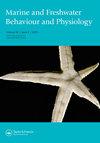潮间带真腹门软体动物的精确觅食时间表
IF 1.1
4区 生物学
Q3 MARINE & FRESHWATER BIOLOGY
Marine and Freshwater Behaviour and Physiology
Pub Date : 2018-03-04
DOI:10.1080/10236244.2018.1505430
引用次数: 1
摘要
大多数关于无壳腹足类动物觅食的研究都集中在普遍存在的多面手海兔(海兔科;金合欢亚科:金合欢属,金合欢属。在这里,我们研究了一种特殊的海兔(海猫,Dolabrifera Dolabrifera;亚科Dolabriferinae)。在巴拿马湾的纳奥斯岛上,有7个不同的潮池,每一个潮池中的座位都在白天退潮低于池高的时候出现,并在1-3小时内返回它们的藏身之处。这种短暂而精确的觅食模式与多面手海兔漫长而多变的时间表形成鲜明对比。结合它们的化学和行为防御能力的降低,这些对海鱼的观察提高了它们在涨潮和夜间躲避捕食者的可能性。本文章由计算机程序翻译,如有差异,请以英文原文为准。
Precise foraging schedule in an intertidal euopisthobranch mollusk
ABSTRACT Most studies of foraging in shell-less gastropods have focused on the ubiquitous generalist sea hares (family Aplysiidae; subfamily Aplysiinae: Aplysia spp., Dolabella spp). Here we studied movement in a specialist sea hare (the seacat, Dolabrifera dolabrifera; subfamily Dolabriferinae). Seacats in each of 7 different tidepools on Isla Naos in the Gulf of Panama emerged precisely when the daytime ebbing tide fell below the height of their pool, returning to their hiding places within 1-3 hours. This short, precise foraging pattern contrasts sharply with long, variable schedule of the generalist sea-hares. Combined with their reduced chemical and behavioral defenses, these observations on seacats raise the possibility that they are avoiding predators during high tides and at night.
求助全文
通过发布文献求助,成功后即可免费获取论文全文。
去求助
来源期刊

Marine and Freshwater Behaviour and Physiology
生物-海洋与淡水生物学
CiteScore
2.10
自引率
0.00%
发文量
9
审稿时长
>12 weeks
期刊介绍:
Marine and Freshwater Behaviour and Physiology is devoted to the publication of papers covering field and laboratory research into all aspects of the behaviour and physiology of all marine and freshwater animals within the contexts of ecology, evolution and conservation.
As the living resources of the world’s oceans, rivers and lakes are attracting increasing attention as food sources for humans and for their role in global ecology, the journal will also publish the results of research in the areas of fisheries biology and technology where the behaviour and physiology described have clear links to the contexts mentioned above.
The journal will accept for publication Research Articles, Reviews, Rapid Communications and Technical Notes (see Instructions for authors for details). In addition, Editorials, Opinions and Book Reviews (invited and suggested) will also occasionally be published. Suggestions to the Editor-In-Chief for Special Issues are encouraged and will be considered on an ad hoc basis.
With the goal of supporting early career researchers, the journal particularly invites submissions from graduate students and post-doctoral researchers. In addition to recognising the time constraints and logistical limitations their research often faces, and their particular need for a prompt review process, accepted articles by such researchers will be given prominence within the journal (see Instructions for authors for details).
 求助内容:
求助内容: 应助结果提醒方式:
应助结果提醒方式:


